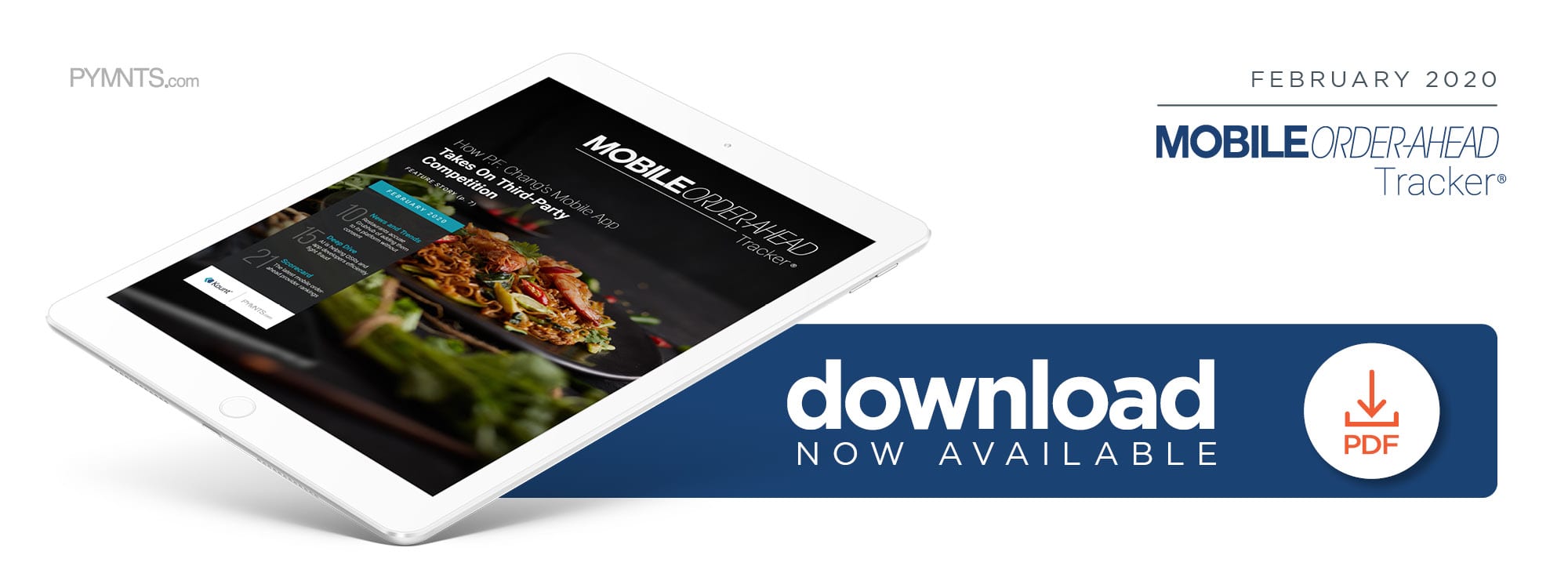
While third-party delivery apps can boost sales and name recognition, many restaurants are eschewing them in favor of proprietary apps. This switch can pay dividends, but it also means they must take the lead in fighting fraud. In this month’s Mobile Order-Ahead Tracker, P.F. Chang’s Whitney French tells PYMNTS how the chain has secured its app via a multi-layered security approach that includes encryption, tokenization and multi-factor authentication.
 Third-party food delivery apps like DoorDash, Grubhub and Uber Eats have revolutionized the restaurant industry, pushing thousands of eateries to introduce new services, and allowing customers to order extravagant meals on a whim. However, some restaurants, including pan-Asian chain P.F. Chang’s, have decided that relying on third-party offerings is not enough, and are instead providing their own in-house delivery services.
Third-party food delivery apps like DoorDash, Grubhub and Uber Eats have revolutionized the restaurant industry, pushing thousands of eateries to introduce new services, and allowing customers to order extravagant meals on a whim. However, some restaurants, including pan-Asian chain P.F. Chang’s, have decided that relying on third-party offerings is not enough, and are instead providing their own in-house delivery services.
“It’s all about being adaptable in this industry,” Whitney French, the chain’s director of digital marketing, told PYMNTS in a recent interview. “When we saw the trend [of] customers using these third-party apps, we, too, wanted to compete in this space by giving our customers a very similar P.F. Chang’s experience.”
P.F. Chang’s developed its mobile app with safety and customer experience in mind, and plans to leverage mobile order-ahead’s popularity to boost purchases at a new takeout-only location in Chicago. The restaurant faced its fair share of challenges along the way, but doing so has proved to be worth the effort.
Cooking Up A Fresh App
P.F. Chang’s rolled out its mobile ordering app in August 2018, but its rewards program has been in place since July 2015. The chain partnered with online food ordering platform Olo to handle order processing, and recently added curbside pickup to existing features like delivery and carry-out. French noted that P.F. Chang’s can provide customers with lower fees and exclusive discounts since it developed its own app, instead of utilizing those that third parties offer.
“We’re able to offer free delivery on orders [of] $25 or more,” she explained, “And if you order … straight from our mobile app, you can earn rewards points — whereas, if you order from third parties, you won’t be able to.”
P.F. Chang’s simple, points-based loyalty model sees customers earning points on their purchases, and redeeming them for free menu items. The rewards program and mobile ordering app both required constant testing and tweaking, French said, even for aspects as simple as the user interface.
“When we rolled it out, there were little quirks that we had to fix,” she said. “[For example], a button not being intuitive enough, or [not doing] what it was supposed to. [We had to take] a step back and look at the numbers, and see why there might’ve been a drop-off from one flow to the other, and then get the recordings and say, ‘Oh, you know what? We know how to fix this.’”
These efforts seem to have paid off, too. P.F. Chang’s reported that off-premises dining accounted for 17 percent of its sales during Q3 2019, up from 14 percent the year prior and two to three times dine-in’s growth, with delivery representing 35 percent of these sales.
This work is meaningless, though, if fraudsters can run amok in user accounts, and restaurants are not immune to emerging, innovative fraud. P.F. Chang’s utilizes numerous security features to protect itself and its customers from account takeovers, brute force attacks and other cybercrimes.
The Secret Sauce Of Security
P.F. Chang’s ordering, payments and security systems rely on cooperation with third-party developers. These firms bring a level of expertise to app development that complements the restaurant team’s existing skills, according to French.
“We partnered with [a customer engagement provider], which uses a single sign-in and multi-factor office authentication to secure access to data,” she said. “Encryption and tokenization are [also] used, and [our partner] actually uses a [payment card industry]-compliant third-party payment processor as well.”
These security measures provide customers with more secure defenses against fraudsters than traditional passwords, as well as smoother sign-in experiences. Striking a balance between security and seamlessness is a constant challenge for all developers, but P.F. Chang’s believes these two needs are compatible.
“At the end of the day, our customers are like everyone else in that they don’t want to think about security,” French explained. “They don’t want to fumble. If you start with making sure that everything is secure, you can really simplify the necessary steps to go through, select [menu] items and go through a payment process. It makes it so that you don’t have an overly complex user experience.”
Mobile Ordering Heads To Real Life
P.F. Chang’s took the lessons it learned in simplifying its mobile ordering experience to its physical restaurant locations, capitalizing on the trend with its new Chicago-based takeout and delivery restaurant. It has a much smaller footprint than the dine-in locations, reaching a mere 2,000 square feet, and offers approximately 80 percent of P.F. Chang’s full menu.
Just 25 percent of American households are located within convenient distances of P.F. Chang’s locations, driving the new restaurant concept’s launch, according to Chris Demery, senior vice president of off-premises dining. The move is becoming common among its competitors, with Applebee’s, Buffalo Wild Wings, Famous Dave’s and IHOP all opening or conducting similar pilot programs — a testament to how mobile order-ahead has changed the restaurant space.
Mobile order-ahead’s continued growth will likely push more brick-and-mortar restaurants to adopt mobile-only or hybrid dining options, and the evolving space will likely inspire further in-person dining innovations. P.F. Chang’s decision to develop its technology in-house, rather than utilize third-party providers, means it will have a much better idea of how to adapt to whatever changes come next.